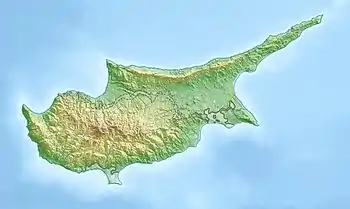1953 Paphos earthquake
The 1953 Paphos earthquake struck British Cyprus (present day Cyprus) on the morning of September 10, at 06:05 EET. It had a magnitude of Ms 6.5 on the surface wave magnitude scale, and had a maximum intensity of X (Extreme) on the Mercalli intensity scale.[1] The epicenter of this earthquake was situated off the island's west coast, near the city of Paphos where 40 people had died, and a least 100 injured. It was reportedly felt in Rhodes, Turkey, Egypt, Lebanon and Kastelorizo.[2]
 Paphos  | |
| UTC time | 1953-09-10 04:06:04 |
|---|---|
| ISC event | 891997 |
| USGS-ANSS | ComCat |
| Local date | September 10, 1953 |
| Local time | 06:05 EET |
| Magnitude | 6.5 Ms 6.3 Mw |
| Epicenter | 34.741°N 32.335°E |
| Areas affected | British Cyprus |
| Total damage | 33,000 buildings damaged |
| Max. intensity | X (Extreme) |
| Tsunami | Yes |
| Casualties | 40 dead 100 injured |
Geological setting
Cyprus is wedged in a complex zone of interaction between the Anatolian (which part of the larger Eurasian Plate) and African Plate. These two plates are colliding along the Cyprus Arc, a plate boundary that runs south of the island. This subduction zone is offset by a small transform fault known as the Paphos Transform Fault. The plate boundary, coupled with the Dead Sea Transform and East Anatolian Fault accommodates motion of the African and Arabian Plates.[3] This has resulted in moderately destructive, mid-range earthquakes, including a magnitude 7.1-7.5 in 1222 which caused great devastation to the island and generated a tsunami.
Earthquake
The earthquake on September 10 was associated with strike-slip faulting along or near the Paphos Transform Fault. It would be one of the most intense tremor ever felt in the region. Forty people were killed and 100 injured, mainly due to collapses as bodies were being pulled from rubbles.[4] Another 4,000 were made homeless in the 158 towns and villages that were affected.[4] The earthquake also triggered landslides which further damaged communities.[5] Shaking was accompanied by a small tsunami which waves were seen along the coast of Paphos without damage.[6][7] Total damage from the quake has been estimated at £2 million (1953 rate).
Response
Rehabilitation and assistance were provided by the Government of the United Kingdom. On September 13, tents and aid supplies were air flown by the Royal Air Force while the Royal Navy sailed through the Suez Canal to help contribute to the recovery efforts. Blankets and clothings were supplied to those affected by the British Red Cross.[8]
References
- "Significant Earthquake Information CYPRUS: PAPHOS". NGDC. Retrieved 12 Dec 2020.
- Nicolaides, Andreas (13 September 2018). "Which were Cyprus' largest earthquakes?". In-Cyprus. Retrieved 12 December 2020.
- Eleftheria Papadimitriou, Vassilios Karakostas (September 2006). "Earthquake generation in Cyprus revealed by the evolving stress field". Tectonophysics. 423.
- A.A.P. "Earthquakes Cause Deaths, Havoc On Cyprus". The Sydney Morning Herald. Archived from the original on 11 September 1953. Retrieved 12 December 2020.
- "The deadly earthquake of Paphos in 1953 - Rare pictures and video". Paphos Life. 13 Sep 2018. Retrieved 12 Dec 2020.
- Anna Fokaefs, Gerassimos A. Papadopoulos (March 2007). "Tsunami hazard in the Eastern Mediterranean: Strong earthquakes and tsunamis in Cyprus and the Levantine Sea". Natural Hazards. 40: 503–526.
- "Tsunami Event Information LEVANTIAN SEA". NGDC. Retrieved 12 Dec 2020.
- "CYPRUS EARTHQUAKE (RELIEF AND REHABILITATION)". Parliament of the UK. October 1953. Retrieved 12 December 2020.